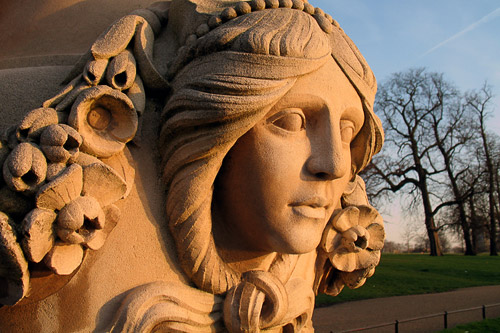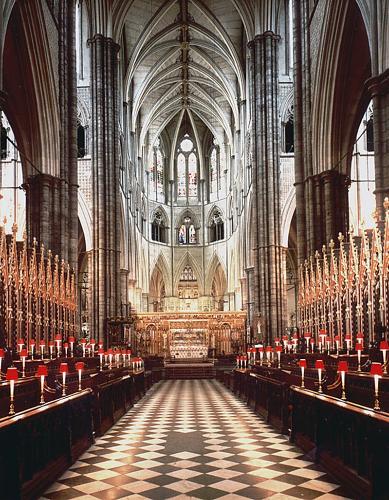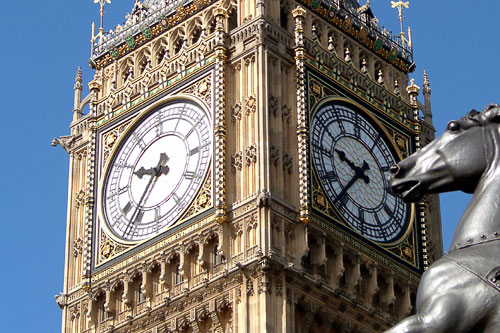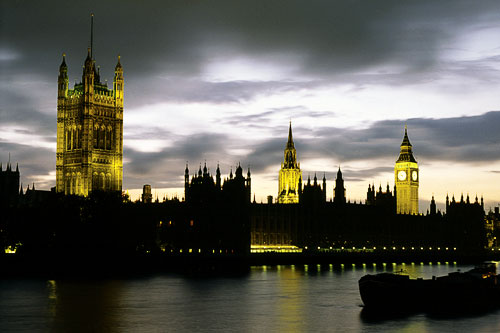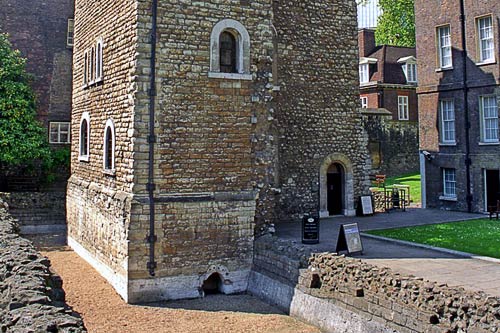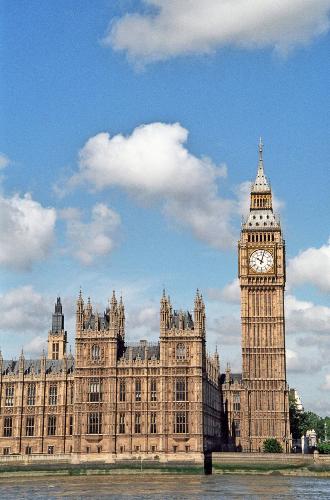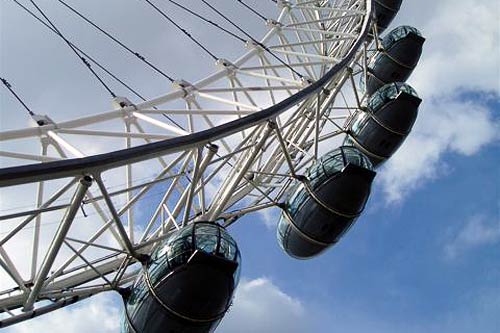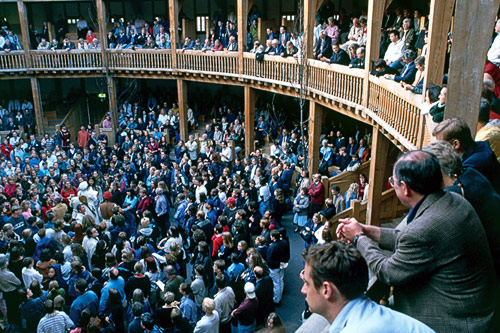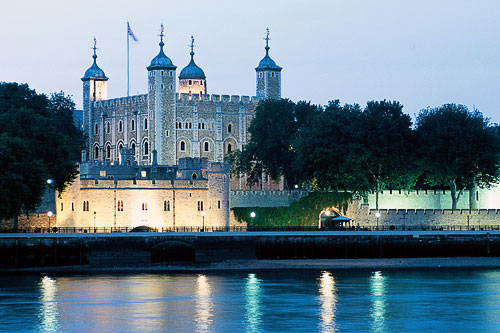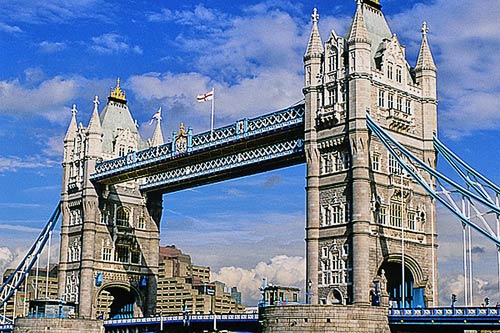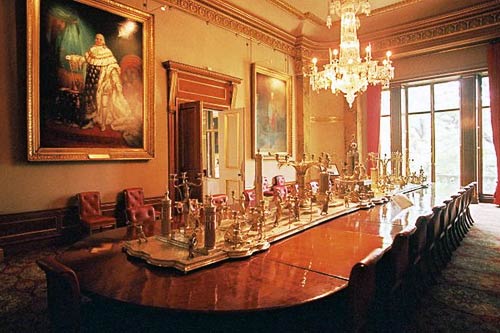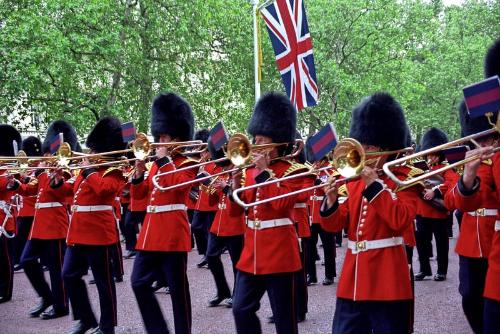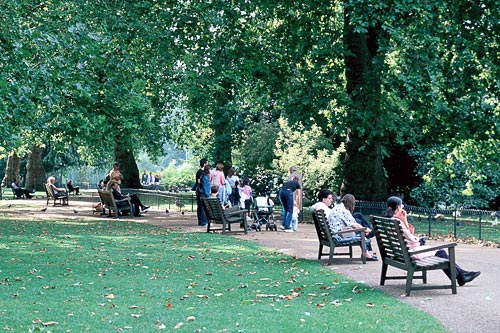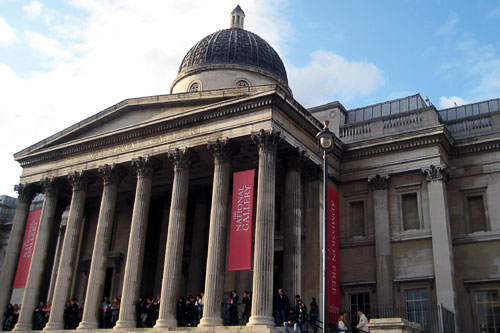How to See the Best of London
By Donald Strachan
With London's abundance of sights, how much can you manage to see in just one trip? Plenty. In this tour, you'll visit the oldest (Westminster Abbey); the newest (British Airways London Eye); and something that stands (time wise) in between: the painstakingly authentic reconstruction of Shakespeare's Globe Theatre. Throw in classic London cityscapes viewed from some of the famous bridges that span the Thames River, and you've got yourself a great two-day tour that won't leave you feeling exhausted.
Photo: Sunset at the Italian Gardens in Hyde Park.
Photo: Sunset at the Italian Gardens in Hyde Park.
Westminster Abbey
Westminster Abbey is one of the finest examples of medieval architecture in Europe. Laid to rest here are the towering figures of English life. Some 3,300 memorials to kings, nobles, and an assortment of church worthies are here for the viewing. William the Conqueror, Edward III (who willed that his heart be removed before burial to rest with his mum's remains in Grey Friar's Church), Mary Queen of Scots, Elizabeth I (whose death mask was the model for her tomb's figure), and Henry V, the hero of Agincourt -- all have elaborately decorated sarcophagi. Don't miss the Gothic ceilings (reflected in a large mirror for close-up viewing), the stained glass in the Chapter House, and the elaborate carvings of the Henry VIII Chapel's choir stalls. And make your way to Poet's Corner, where you'll find monuments to wellloved literary names such as Chaucer, Austen, and Dickens.
Details: Arrive before 9:30am to avoid lines. 20 Dean's Yard; tel. 0207/222-5152; www.westminster-abbey.org. Tube: Westminster.
Details: Arrive before 9:30am to avoid lines. 20 Dean's Yard; tel. 0207/222-5152; www.westminster-abbey.org. Tube: Westminster.
Big Ben
The iconic Clock Tower at the eastern end of the Palace of Westminster has come to be known as Big Ben, though that appellation really refers to the largest bell in the clock's chime. The 14-ton bell, installed in 1858, is believed to have been named forthe commissioner of public works at the time -- Sir Benjamin Charles -- although some historians insist it was named for a famous boxer of the era, Benjamin Caunt. Brits can make the ascent up the tower's 334 spiral steps by special guided tour, but non-U.K. citizens must content themselves with a must-have snapshot.
Details: Near St. Stephen's Entrance of Westminster Palace, Old Palace Yard. British citizens should contact their local MP to apply for permission to tour the clock tower.
Details: Near St. Stephen's Entrance of Westminster Palace, Old Palace Yard. British citizens should contact their local MP to apply for permission to tour the clock tower.
Houses of Parliament
The immense 3-hectare (7.4-acre) Palace of Westminster, a splendid example of Gothic Revival architecture, dates back to 1840 (the original palace was all but destroyed by fire in 1834). It's the home of the House of Commons (where elected officials do their legislating) and the House of Lords (where they second-guess the decisions made in the Commons). Both houses are often open for both audio and guided on days when Parliament is not sitting, which means most weekends.
Details: Old Palace Yard; tel. 0207/219-3000 House of Commons; 0207/219-3107 House of Lords; www.parliament.uk/visiting. Tube: Westminster.
Details: Old Palace Yard; tel. 0207/219-3000 House of Commons; 0207/219-3107 House of Lords; www.parliament.uk/visiting. Tube: Westminster.
The Jewel Tower
This medieval structure was one of only two buildings to survive an 1834 fire that destroyed the original Palace of Westminster. The tower dates back to 1365 and was originally used to house Edward III's wardrobe and treasures. Today, it's home to a very informative exhibit, "Parliament Past & Present," which details the inner workings of the British government. Look carefully at the building's exterior as you enter and you'll spot the remains of a moat.
Details: Abingdon St; tel. 0207/222-2219; www.english-heritage.org.uk. Tube: Westminster
Details: Abingdon St; tel. 0207/222-2219; www.english-heritage.org.uk. Tube: Westminster
Westminster Bridge
From the center of this bridge you can enjoy a sweeping view of the Houses of Parliament and the Elizabeth Tower, which contains the bell known as Big Ben—one of the most familiar and beloved cityscapes in the world.
Details: Tube: Westminster.
Details: Tube: Westminster.
British Airways London Eye
The huge Ferris wheel that solemnly rotates at one revolution per half-hour has quickly become a London icon. It graces the skyscape from far away and is much loved by even the most hardened London traditionalists. Although it was originally planned for only a 5-year stint, there's no way the city can let it go. Show up 30 minutes before your scheduled departure time (15 if you have a Fast Track ticket). Don't forget your camera. Plan your trip for around sunset for some gorgeous colors.
Details: Book through the website for a 10% discount. South Bank (at Westminster Bridge); tel. 0870/500-0600; www.londoneye.com. Tube: Westminster.
Details: Book through the website for a 10% discount. South Bank (at Westminster Bridge); tel. 0870/500-0600; www.londoneye.com. Tube: Westminster.
Shakespeare's Globe Theatre
Even if you don't have tickets to a play, the Globe is a fascinating place to visit. It was rebuilt in painstaking detail on a parking lot near the site of the original theater (and only those tools authentic to the period of the original were used in its construction). It was at the Globe in the late 1500s/early 1600s that Shakespeare's comedies and tragedies were performed in daylight (as they are now) to delight the nobility (who sat in the tiers) as well as the rabble (who stood before the stage). You can choose either option when purchasing tickets, weighing comfort versus proximity to the stage. Changing exhibits focus on related topics such as the frost fairs of medieval London (back when the Thames would freeze into solid terrain, and people would party on the river for days); or the juicy history of nearby Southwark, once a haven for prostitutes, thieves,and actors.
Details: 21 New Globe Walk; tel. 0207/902-1500 (exhibition) or 0207/401-9919 (box office); www.shakespeares-globe.org. Closed during afternoon theater matinees—check ahead for schedules. Tube: London Bridge.
Details: 21 New Globe Walk; tel. 0207/902-1500 (exhibition) or 0207/401-9919 (box office); www.shakespeares-globe.org. Closed during afternoon theater matinees—check ahead for schedules. Tube: London Bridge.
Hungerford Bridge
Many people know about the gorgeous sliver of a footbridge connecting the Tate Modern on Bankside to St. Paul's Cathedral and the City, but fewer know the name of the footbridge connecting Charing Cross station to South Bank. That's the Hungerford Bridge. On its southern flank, you see the London Eye and Parliament, and on the north, you see the city to St. Paul's dome and beyond.
Details: Tube: Charing Cross, Embankment, or Waterloo.
Details: Tube: Charing Cross, Embankment, or Waterloo.
St. Paul's Cathedral
For centuries, the Dome of St. Paul's had no competition in the skyline of London; it was the highest and most impressive building in town. Though it has since been dwarfed by the skyscrapers in the financial district, none of them inspires the same awe as Sir Christopher Wren's masterpiece, built after the Great Fire of 1666. The cathedral is the culmination of Wren's unique and much-acclaimed fusion of classical (the exterior Greek-style columns) and baroque (the ornate interior decorations) architecture. The Whispering Gallery is a miracle of engineering, in which you can hear the murmurs of another person from across a large gallery. The 530 stairs to the top are demanding, but you'll be rewarded with a magnificent view, not only of London, but of the marvel of the cathedral, which Wren -- who is buried alongside many notable scientists and artists in the church's crypt -- considered his ultimate achievement and most demanding effort.
Details: There are guided tours at 11am, 11:30am, 1:30pm, and 2pm. Ludgate Hill, EC4 (at Paternoster Sq.); tel. 0207/236-4128; www.stpauls.co.uk. Tube: St. Paul's.
Details: There are guided tours at 11am, 11:30am, 1:30pm, and 2pm. Ludgate Hill, EC4 (at Paternoster Sq.); tel. 0207/236-4128; www.stpauls.co.uk. Tube: St. Paul's.
Tower of London
Built by William the Conqueror in 1066, this fortress was added to by subsequent generations of kings and queens up to the Victorian Age, and is now an incomparable collection of buildings that reflect the range of England's architectural styles over the past millennium. The Tower has a bloody past marked by power struggles, executions, and cruelty: The young nephews of Richard III were murdered here in 1483; two of Henry VIII's six wives (Anne Boleyn and Catherine Howard) were beheaded on Tower Green, as was the 9-day queen, Lady Jane Grey; and Sir Walter Raleigh left his name on a walkway by his prison cell. Yeoman Warders (or "Beefeaters") give sprightly talks all day long, and talented actors offer living history lessons as they wander about in period costumes. The Crown Jewels are the most popular sight, just edging out the Torture Exhibit; the two together represent the awful accouterments of power (and have the longest lines). The Tower, quite justifiably regarded as one of the most haunted -- and haunting -- places in London, will thrill students of history, and entertain kids as well.
Details:Buy your tickets online & arrive before 9am to avoid the long line and save a small amount of money, as well as time. Tower Hill; 0870/756-6000; www.hrp.org.uk. Tube: Tower Hill.
Details:Buy your tickets online & arrive before 9am to avoid the long line and save a small amount of money, as well as time. Tower Hill; 0870/756-6000; www.hrp.org.uk. Tube: Tower Hill.
Tower Bridge
This picture-perfect bascule bridge -- a term derived from the French for "seesaw" -- has spanned the Thames since 1894. There's no denying the physical beauty of the neo-Gothic bridge: Its skeleton of steel girders is clothed with ornate masonry using Cornish granite and Portland stone designed to harmonize elegantly with the neighboring Tower of London. Its lower span opens and closes through hydraulics and behemoth machinery -- details that even engineering-challenged visitors will find fascinating on the "Tower Bridge Experience" tour. Tour participants can also ascend to the bridge's top level for a bird's-eye view of the Tower of London and the Thames, 43m (141 ft.) below. (Acrophobics need not apply.)
Details: Tower Bridge; tel. 0207/403-3761; www.towerbridge.org.uk. Tube: Tower Hill.
Details: Tower Bridge; tel. 0207/403-3761; www.towerbridge.org.uk. Tube: Tower Hill.
Apsley House
Designed by famed architect Robert Adam, this neoclassical mansion was purchased by Arthur Wellesley, first Duke of Wellington (1769-1852), following his victories in the Napoleonic Wars. Its location, just past the old Knightsbridge tollgate, gave it the city's most grandiose address at the time: Number One London. The residence houses a renowned collection of decorative arts (many of the pieces bestowed upon the duke by grateful European monarchs), historic weaponry, numerous Old Masters, a towering nude statue of his enemy Napoleon (with a strategic fig leaf), and magnificent views of Hyde Park. It's a small, quick-hit museum that provides you with a taste of old Georgian splendor. (Don't miss the staggeringly over-the-top silver table setting, with an 8m-long/26-ft. centerpiece.)
Details: 149 Piccadilly; tel. 0207/499-5676; www.english-heritage.org.uk. Tube: Hyde Park Corner.
Details: 149 Piccadilly; tel. 0207/499-5676; www.english-heritage.org.uk. Tube: Hyde Park Corner.
Buckingham Palace
Buck House, the queen's famous abode in London (if the yellow-and-red Royal standard is flying, it means she's there), is the setting for the pageantry of the Changing of the Guard, a London tradition that attracts more people than it warrants and a nightmarish mass of crowds in the summer. A better place to see all the queen's horses and all the queen's men in action is the Horse Guards Parade. But if you're determined to see the guards change here, arrive a half hour early to get a seat by the statue of Victoria in front of the palace; it offers a reasonably good view.
Details: The ritual takes place every other day in winter and every day in summer at 11am in the forecourt of the palace. At end of The Mall (on the road running from Trafalgar Sq.); tel. 020/7766-7300; www.royalcollection.org.uk. Admission: Changing of the Guard free. Tube: St. James's Park, Green Park, or Victoria
Details: The ritual takes place every other day in winter and every day in summer at 11am in the forecourt of the palace. At end of The Mall (on the road running from Trafalgar Sq.); tel. 020/7766-7300; www.royalcollection.org.uk. Admission: Changing of the Guard free. Tube: St. James's Park, Green Park, or Victoria
St. James's Park
Arguably London's prettiest park, St. James's has an interesting history. The former swamp was tidied up in the 18th century, and evolved into a popular and notorious scene where prostitutes conducted business, laundresses brought their loads to dry on bushes, and drunken rakes took unsteady aim at dueling opponents. Now, however, it's very respectable, with a duck and pelican pond, weeping willows, and numerous paths lined with flower beds. The benches at the eastern end of the park offer a peaceful view of London's landmarks.
Details: East of Hyde Park, across Piccadilly. Tube: St. James's Park.
Details: East of Hyde Park, across Piccadilly. Tube: St. James's Park.
National Gallery
This revered museum dominating Trafalgar Square sits roughly where the stables of King Henry VIII used to be. Founded in 1832 with a collection of 38 paintings bought by the British government, the National is now home to some 2,000 works representing the world's major artistic periods from 1250 to 1900. It's London's best museum for anyone interested in the arts.
Details: N. side of Trafalgar Sq.; tel. 020/7747-2885; www.nationalgallery.org.uk. Admission free. Thurs-Tues 10am-6pm; Wed 10am-9pm. Tube: Charing Cross or Leicester Sq.
Details: N. side of Trafalgar Sq.; tel. 020/7747-2885; www.nationalgallery.org.uk. Admission free. Thurs-Tues 10am-6pm; Wed 10am-9pm. Tube: Charing Cross or Leicester Sq.
Covent Garden
This famous marketplace -- first laid out in the 17th century -- is a good spot to end any day of cultural explorations. The area is bordered by the Strand, Charing Cross, Drury Lane, and High Holborn. At its heart is the Inigo Jones-designed arcade now filled with upscale shops and uninspired cafes. Jubilee Market, with inexpensive whatnots and cheap clothing, is set on the southern side of the arcade; at the western end you'll find stalls that, depending on the day, offer antiques, handmade crafts, or flea market goods. You may even be lucky enough to come upon an operatic performance given by professionals from the neoclassical Royal Opera House that faces the arcade. This area offers busking at its best; be it a tattooed man juggling knives, or a chamber music quartet, you'll always find real talent in Covent Garden's street entertainment.
Details: Tube: Covent Garden.
Details: Tube: Covent Garden.





